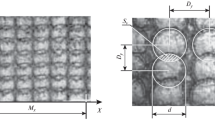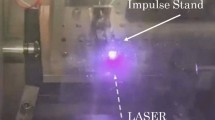Abstract
Recoil momentum due to ablated products in the laser ablation process is the dominant source of thrust generation. The total momentum comprises the laser-supported shock wave in background gas and the momentum due to material flow. Based on experimental studies, the dependence of laser ablation propulsion parameters of metal foils has been investigated in atmospheric air. A Q-switched Nd:YAG laser operating at fundamental (1064 nm) and second harmonics (532 nm) is used to irradiate the target. Each sample's ablation is performed over a range of laser fluence values (106 to 107 J/cm2), which is achieved by varying the incoming laser energy per pulse and adjusting the focused beam spot diameter. The results obtained from these studies showed that the laser ablation propulsion parameters are influenced by laser parameters. Moreover, the target properties also plays significant role in calculating propulsion parameters which vary with wavelength. The highest Cm is obtained for Cu irradiated with 2.2 × 10–4 Ns/J laser pulse using fundamental harmonics at low laser fluence up to 1.5 × 106 J/cm2while at the highest fluence Fe gives higher Cm 1.810–4 Ns/J because of the difference in the physical properties of metal foils. As expected, changing the energy per pulse of the laser also affects the laser ablation propulsion efficiency. The Isp for Fe is highest for both harmonics i-e 41,675 s and 3490 s, respectively. The reason behind this is that the optical properties of Fe vary by changing wavelength. Such higher Isp is required for long-range missions, so Fe proved to be the best propellant.








Similar content being viewed by others
References
Kotsedi, L.; Furlan, V.; Bharadwaj, V.; Kaviyarasu, K.; Sotillo, B.; Mtshail, C.B.; Matinise, N.; Demir, A.G.; Previtali, B.; Ramponi, R.; Eaton, S.M.; Maaza, M.: Chromium oxide formation on nanosecond and femtosecond laser irradiated thin chromium films. Opt. Mater. 95, 109206 (2019)
An, J.H.; Li, Q.; Bhang, D.H.; Song, W.J.; Youn, H.Y.: TNF-α and INF-γ primed canine stem cell-derived extracellular vesicles alleviate experimental murine colitis. Sci. Rep. 10, 1–14 (2020)
Kotsedi, L.; Kaviyarasu, K.; Fuku, X.G.; Eaton, S.M.; Amara, E.H.; Bireche, F.; Ramponi, R.; Maaza, M.: Two temperature approach to femtosecond laser oxidation of molybdenum and morphological study. Appl. Surf. Sci. 421, 213–219 (2017)
Grewal, A.; Wang, Y.; Munks, M.; Kern, K.; Ternes, M.: Local stiffness and work-function variations of hexagonal boron nitride on Cu(111). Beilstein Arch. 202130 (2021)
Schall, W.O.; Eekesand, H.A.; Bohn, W.L.: Laser ablation and its applications. Springer, Berlin (2007)
Phipps, C.; Birkan, M.; Bohn, W.; Eckel, H.A.; Horisawa, H.; Lippert, T.; Michaelis, M.; Rezunkov, Y.; Sasoh, A.; Schall, W.; Scharring, S.; Sinko, J.: Review: Laser-Ablation Propulsion. J. Propul. Power 26(4), 609–637 (2010)
Pakhomov, A.; Lin,V.J.; Cohen,T.; Thompson, M.S.: Two-pulsed ablation of graphite and other elementary propellants for ablative laser propulsion. In: 34th AIAA Plasmadynamics and Lasers Conference, vol. 3863, pp. 1–7 (2003)
D'souza, B.C.;Ketsdever,A.D.: Direct impulse measurements of ablation processes from laser-surface interactions. 36th AIAA Plasmadynamics and Lasers Conference.5172,1–9(2005).
Zhang, N.; Wang, W.; Zhu, X.; Liu, J.; Xu, K.; Huang, P.; Zhao, J.; Li, R.; Wang, M.: Investigation of ultrashort pulse laser ablation of solid targets by measuring the ablation-generated momentum using a torsion pendulum. Opt. Express 19(9), 1–9 (2011)
Zhao, X.; Tang, T.; Han, F.B.; Ni, X.W.: The influence of laser ablation plume at different laser incidence angle on the impulse coupling coefficient with metal target. J. Appl. Phys. 120(213103), 1–9 (2016)
Pakhomov, A.V.; Gregory, D.A.: Ablative laser propulsion: An Advanced concept of space transportation. Young Fac. Res. Proc. 664, 63–72 (2000)
Ren, J.; Ahmed, R.; Butt, H.: Finite element analysis of nanosecond pulsed laser ablation of various materials. World J. Eng. 14(6), 489–496 (2017)
Zheng, Z.Y.; Lu, X.; Hao, Z.Q.; Yuan, X.H.; Wang, Z.H.; Wei, Z.Y.: Characteristic investigation of ablative laser propulsion driven by nanosecond laser pulses. Appl. Phys. Mater. Sci. Proc. 83, 329–332 (2006)
Phipps, C.R.; Turner, T.; Harrison, R.; York, G.; Osborne, W.; Anderson, G.; Corlis, X.; Haynes, L.; Steele, H.; Spicochi, K.; King, T.: Impulse coupling to targets in vacuum by KrF, HF and CO2 lasers. J. Appl. Phys. 64(3), 1083–1096 (1988)
Zhu, X.; Zhang, N.: Investigation of ultrashort pulse laser propulsion using time-resolved shadowgraphy and torsion pendulum. In: International Symposium on Photoelectronic Detection and Imaging 2009: Laser Sensing and Imaging. (2009). https://doi.org/10.1117/12.839584
Beverly, R.E.; Walters, C.T.: Measurement of CO2-laser induced shock pressures above and below LSD-wave thresholds. J. Appl. Phys. 47(8), 3485–3495 (1976)
Vladoiu, I.; Stafe, M.; Negutu, C.; Popescu, I.M.: Nanosecond ablation rate of metals dependence on the laser fluence and wavelength in atmospheric air U.P.B. Sci. Bull. Ser. A. 70(4), 119–126 (2008)
Cristoforetti, G.; Legnaioli, S.; Palleschi, V.; Tognoni, E.; Benedetti, P.A.: Observation of different mass removal regimes during the ablation of an aluminium target in air. J. Anal. Atomic Spectrosc. 23(11), 1518–1528 (2008)
Acknowledgements
The authors are thankful to the Higher Education Commission of Pakistan for providing financial support to carry out the research work. The LASER system used in the ablation studies was obtained through grant No. NRPU 6409 of HEC, Pakistan.
Author information
Authors and Affiliations
Corresponding author
Rights and permissions
About this article
Cite this article
Saeed, H., Jamil, Y., Younas, A. et al. Quantitative Measurements of Ablative Laser Propulsion Parameters of Metal Foils Using Pulsed Nd:YAG Laser. Arab J Sci Eng 47, 895–901 (2022). https://doi.org/10.1007/s13369-021-05739-9
Received:
Accepted:
Published:
Issue Date:
DOI: https://doi.org/10.1007/s13369-021-05739-9




